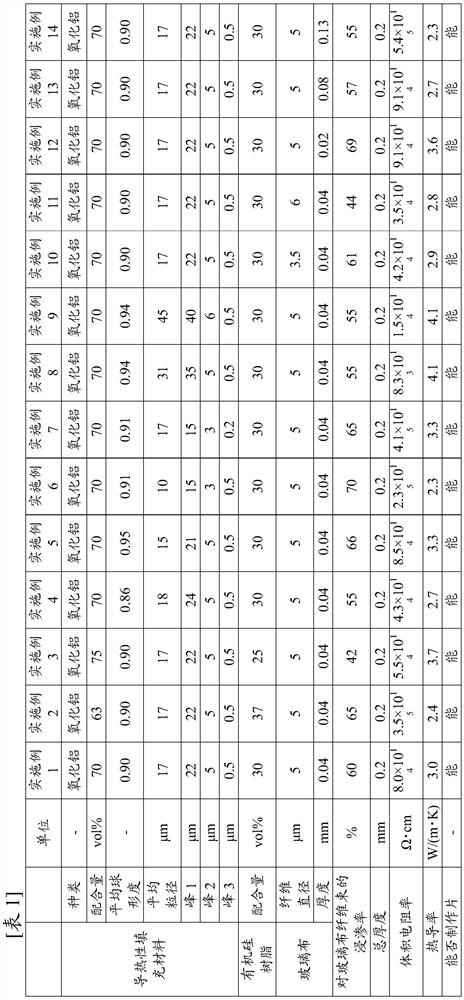Heat sink and heat dissipation member including the heat sink
A heat sink and glass cloth technology, applied in the direction of electrical components, semiconductor devices, electric solid devices, etc., can solve the problems of heat sink thermal conductivity reduction, insulation damage, low thermal conductivity, etc., to achieve efficient punching processing, The effect of high insulation and high thermal conductivity
- Summary
- Abstract
- Description
- Claims
- Application Information
AI Technical Summary
Problems solved by technology
Method used
Image
Examples
Embodiment 1
[0045] Polyorganosiloxane base polymer (Dow Corning Toray Co., Ltd. trade name "CF3110") and crosslinking agent (Dow Corning Toray Co., Ltd. trade name "RC-4") were mixed in a weight ratio They were mixed at a ratio of 100:1 to obtain a silicone resin component. The obtained silicone resin component and alumina powder as a thermally conductive filler were filled at the volume % shown in Table 1 and Table 2, and mixed with a mixer for 15 hours to prepare an alumina-containing silicone composition.
[0046] The average sphericity of the thermally conductive filler (alumina powder) was measured as follows using a flow particle image analyzer (manufactured by Sysmex Corporation, trade name "FPIA-3000"). The projected area (A) and perimeter (PM) of the particles were determined from the particle images. Assuming (B) is the area of a perfect circle corresponding to the circumference (PM), the sphericity of the particle can be expressed as A / B. Therefore, if it is assumed to be a...
Embodiment 2~14 and comparative example 1~10
[0050] Except having adopted the conditions shown in Tables 1-2, it carried out similarly to Example 1, and produced the heat sink.
[0051] (evaluate)
[0052] The following evaluation items (1)-(5) were performed about the heat sink of the trial-produced Examples 1-14 and Comparative Examples 1-10. The results are shown in Tables 1-2. It should be noted that, for an example in which a heat sink cannot be normally produced in a sheet form (caused by looseness or surface cracks), "whether the sheet can be produced" is described as "impossible".
[0053] (1) Volume resistivity
[0054] The volume resistivity was evaluated according to the method described in JIS C 2139:2008. As a measuring device, a superinsulator (trade name "SM-10E" manufactured by Hioki Electric Co., Ltd.) was used.
[0055] (2) thermal conductivity
[0056] For thermal conductivity (H; unit W / (m·K)), the evaluation was performed in the thickness direction of the heat sink. According to thermal diffusi...
PUM
| Property | Measurement | Unit |
|---|---|---|
| particle size | aaaaa | aaaaa |
| thickness | aaaaa | aaaaa |
| diameter | aaaaa | aaaaa |
Abstract
Description
Claims
Application Information
 Login to View More
Login to View More - R&D
- Intellectual Property
- Life Sciences
- Materials
- Tech Scout
- Unparalleled Data Quality
- Higher Quality Content
- 60% Fewer Hallucinations
Browse by: Latest US Patents, China's latest patents, Technical Efficacy Thesaurus, Application Domain, Technology Topic, Popular Technical Reports.
© 2025 PatSnap. All rights reserved.Legal|Privacy policy|Modern Slavery Act Transparency Statement|Sitemap|About US| Contact US: help@patsnap.com


